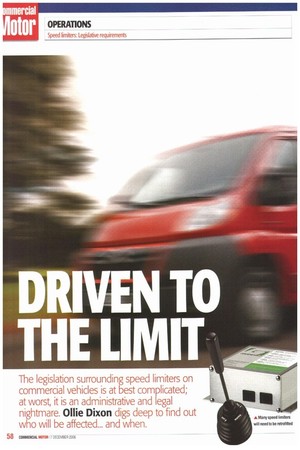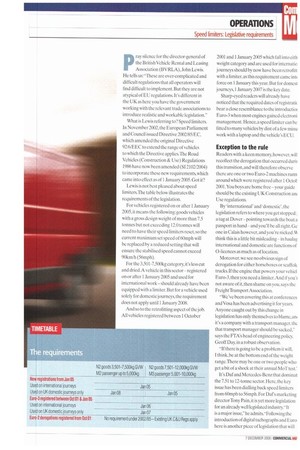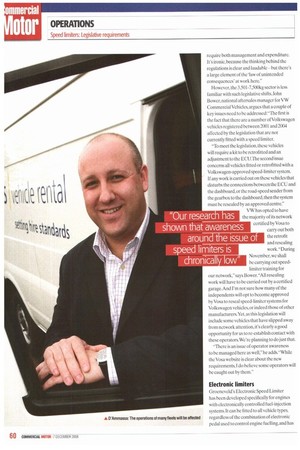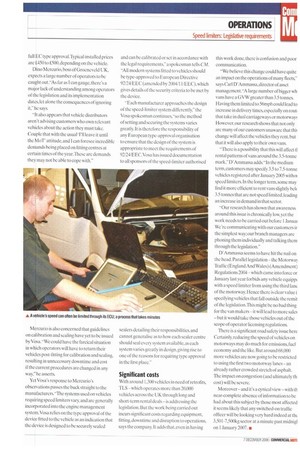DR VEN TO THE I. MIT
Page 58

Page 59

Page 60

Page 61

If you've noticed an error in this article please click here to report it so we can fix it.
The legislation surrounding speed limiters on commercial vehicles is at best complicated; at worst, it is an administrative and egal
nightmare. 011ie Dixon digs deep to find out
who will be affected... and when.
pray silence for the director-general of the British Vehicle Rental and Leasing Association (BVRLA), John Lewis. He tells us: "These are over-complicated and difficult regulations that all operators will find difficult to implement. But they are not atypical of EU regulations. It's different in the UK as here you have the government working with the relevant trade associations to introduce realistic and workable legislation."
What is Lewis referring to? Speed limiters. In November 2002, the European Parliament and Council issued Directive 2002/85/EC, which amended the original Directive 92/6/EEC to extend the range of vehicles to which the Directive applies.The Road Vehicles (Construction & Use) Regulations 1986 have now been amended (SI 2102/2004) to incorporate these new requirements, which came into effect as of 1 January 2005. Got it?
Lewis is not best pleased about speed limiters.The table below illustrates the requirements of the legislation.
For vehicles registered on or after 1 January 2005, it means the following: goods vehicles with a gross design weight of more than 75 tonnes but not exceeding 12.0 tonnes will need to have their speed limiters reset, so the current maximum set speed of 60mph will be replaced by a reduced setting that will ensure the stabilised speed cannot exceed 90km/h (56mph).
For the 3,501-7,500kg category, it's less cut and dried.A vehicle in this sector -registered on or after 1 January 2005 and used for international work should already have been equipped with a limiter. But for a vehicle used solely for domestic journeys, the requirement does not apply until !January 2008.
And so to the retrofitting aspect of the job. All vehicles registered between 1 October 2001 and 1 January 2005 which fall into eith weight category and are used for in tematic journeys should by now have been re trofitt with a limiter, as this requirement came int( force on 1 January this year. But for domest journeys.1 January 2007 is the key date.
Sharp-eyed readers will already have noticed that the required dates of registrati( bear a close resemblance to the introductioi Euro-3 when most engines gained electroni management. Hence,a speed limiter can be fitted to many vehicles by dint of a few minu work with a laptop and the vehicle's ECU
Exception to the rule
Readers with a keen memory, however, will recollect the derogation that occurred durit this transition,and will therefore observe there are one or two Euro-2 machines runn around which were registered after 1 Octot 2001, You boys are home free your guide should be the existing UK Construction an Use regulations.
By'intemationai and 'domestic', the legislation refers to where you get stopped:, a tug at Dover pointing towards the boat a passport in hand and you'll be all right. Ge one in Calais however, and you're nicked.V■ think this is a little bit misleading in haulag international and domestic are functions of 0-licences as much as of location.
Moreover, we see no obvious sign of derogation for either horseboxes or scaffolc trucks. If the engine that powers your vehicl Euro-3, then you need a limiter.And if you'i not aware of it, then shame on you,says the Freight Transport Association.
-We've been covering this at conferences and Vosa has been advertising it for years. Anyone caught out by this change in legislation has only themselves to blame, an it's a company with a transport manager. thc that transport manager should be sacked," says the FTA's head of engineering policy. Geoff Day. in a robust observation.
"If there is going to be a problem it will, I think, be at the bottom end of the weight range.There may be one or two people who get a bit of a shock at their annual MoT test.'
It's Daf and Mercedes-Benz that dominat the 7.51 to 12-tonne sector. Here, the key issue has been dialling back speed limiters from hOmph to 56mph. For Dais marketing director Tony Pain,it is yet more legislation for an already well legislated industry."It is a major issue," he admits."Following the introduction of digital tachographs and Eurc. here is another piece of legislation that will require both management and expenditure. It's ironic, because the thinking behind the regulations is clear and laudable -but there's a large element of the 'law of unintended consequences' at work here," However, the 1501-7.500kg sector is less familiar with such legislative shifts. John Bower, national a ftersales manager for VW Commercial Vehicles, argues that a couple of key issues need to be addressed: "The first is the fact that there are a number of Volkswagen vehicles registered between 2001 and 2004 affected by the legislation that are not currently fitted with a speed limiter.
"To meet the legislation, these vehicles will require a kit to be retrofitted and an adjustment to the ECUThe second issue concerns all vehicles fitted or retrofitted with a Volkswagen-approved speed-limiter system. If any work is carried out on these vehicles that disturbs the connections between the ECU and the dashboard, or the road-speed sender from t he gearbox to the dashboard, then the system must be resealed by an approved centre."
VW has opted to have the majority of its network certilied by Vosa to carry out both the retrofit and resealing work.-During November, we shall be carrying out speedlimiter training for our network," says Bower."All resealing work will have to be carried out by a certified garage.And I'm not sure how many of the independents will opt to become approved by Vosa to reseal speed-limiter systems for Volkswagen vehicles, or indeed those of other manufacturers.Yet, as this legislation will include some vehicles that have slipped away from network attention, it's clearly a good opportunity for us to re-establish contact with these operators.We 're planning to do just that.
"There is an issue of operator awareness to be managed here as well," he adds."While the Vosa website is clear about the new requirements, I do believe some operators will he caught out by them."
aroun the issue of chronica I low"
Electronic limiters Groeneveld's Electronic Speed Limiter has been developed specifically for engines with electronically controlled fuel-injection systems. It can be fitted to all vehicle types. regardless of the combination of electronic pedal used to control engine fuelling, and has full EC type approval.Typical installed prices are £450 to £500, depending on the vehicle.
Dino Mercurio, boss of Groeneveld UK, expects a large number of operators to he caught out."As far as I can gauge, there's a major lack of understanding among operators of the legislation and its implementation dates, let alone the consequences of ignoring it," he says.
It also appears that vehicle distributors aren't advising customers who own relevant vehicles about the action they must take. Couple that with the usual 'I'll leave it until the Mor attitude, and I can foresee incredible demands being placed on fitting centres at certain times of the year.These are demands they may not be able to cope with."
Mercurio is also concerned that guidelines on calibration and sealing have yet lobe issued by Vosa."We could have the farcical situation in which operators will have to return their vehicles post-fitting for calibration and sealing, resulting in unnecessary downtime and cost if the current procedures are changed in any way." he asserts.
Yet Vosa's response to Mercurio's observations passes the buck straight to the manufacturers. "The systems used on vehicles requiring speed limiters vary, and arc generally incorporated into the engine management system. Vosa relies on the type approval of the device fitted to the vehicle as an indication that the device is designed to be securely sealed and can be calibrated or set in accordance with the legal requirements," a spokesman tells CM. "All modern systems fitted to vehicles should be type-approved to European Directive 92/24/EEC (amended by 2004/11/EEC), which gives details of the security criteria to be met by the device.
"Each manufacturer approaches the design of the speed-limiter system differently," the Vosa spokesman con t in ues,''so the method of setting and securing the systems varies greatly. It is therefore the responsibility of any European type-approval organisation to ensure that the design of the system is appropriate to meet the requirements of 92/24/EEC.Vosa has issued documentation to all sponsors of the speed-limiter authorised sealers detailing their responsibilities, and cannot generalise as to how each sealer centre should seal every system available, as each system varies greatly in design,giving rise to one of the reasons for requiring type approval in the first place."
Significant costs
With around 1,300 vehicles in need of retrofits, TLS -which operates more than 20,000 vehicles across the UK through long and short-term rental dealsis addressing the legislation. But the work being carried out incurs significant costs regarding equipment. fitting. downtime and disruption to operations. says the company. It adds that, even in having this work done, there is confusion and poor communication.
"We believe this change could have quite an impact on the operations of many fleets," says Carl D'Ammassa,director of asset managcrnent.-A large number of bigger wh vans have a GVW greater than 3.5 tonnes. Having them limited to 56mph could lead to increase in delivery times, especially on rout that take in dual carriageways or motorways However,our research shows that not only arc many of our customers unaware that this change will affect the vehicles they rent, but that it will also apply to their own vans.
"There is a possibility that this will affect ti rental patterns of vans around the 3.5-tonne mark," D'Ammassa adds."In the medium term,customers may specify 35 to 7.5-tonne vehicles registered afterJanuary 2005 withot speed limiters. In the longer term,some may find it more efficient to rent vans slightly belc 3.5 tonnes that arc not speed I imited, leading an increase in demand in that sector, "Our research has shown that awareness around this issue is chronically low, yet the work needs to he carried out before 1 Januai We're communicating with our customers ir the simplest way; our branch managers arc phoning them individually and talking them through the legislation."
D' Ammassa seems to have hit the nail on the head. Parallel legislation the Motorwa3 Traffic (England And Wales) (Amendment) Regulations 2004which came into force or January last year forbids any vehicle equippt with a speed limiter from using the third Ian( of the motorway. Hence there is clear value i specifying vehicles that fall outside the remit of the legislation.This might be no had thing for the van makers-it will lead to more sales but it would take those vehicles out of the scope of operator licensing regulations.
There is a significant road safety issue here Certainly, reducing the speed of vehicles on motorways may do much for emissions, fuel economy and the like. But around 68.000 more vehicles are now going to be restricted to using the first two motorway lanes an already rather crowded stretch of asphalt. The impact on congestion (and ultimately th, cost) will be severe.
Moreover and it's a cynical view -with th near-complete absence of information to be had about this subject by those most affected it seems likely that any switched-on traffic officer will be looking very hard indeed at tin 3,501-7,500kg sector at a minute past midnigl on 1 January 2007. •
11111131MM
Nevi registrations from Jan 05 Used an international journeys Used on UK domestic journeys only Euro-3 registered between Oct01 & Jan 05 Used on international journeys Used on UK domestic journeys only Euro-2 derogations registered from Oct 01
N2 goods 3,501-7,500kg GVW M2 passenger up to 5,000kg N2 goods 7,501-12,000kg GVVV M3 passenger 5,001-10,000kg Jan 05 Jan 08 Jan 05 Jan 06 Jan 07 No requirement under 2002/85 —Existing UK C&U Regs apply


































































































































































































